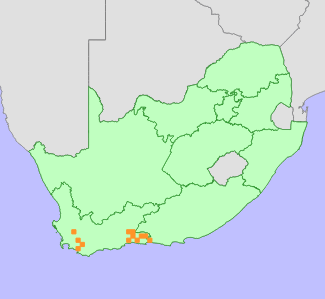|
Scientific Name | Disa spathulata (L.f.) Sw. subsp. tripartita (Lindl.) H.P.Linder |
Higher Classification | Monocotyledons |
Family | ORCHIDACEAE |
Synonyms | Disa tripartita Lindl., Herschelia spathulata (L.f.) Rolfe (in part), Herschelia spathulata (L.f.) Rolfe subsp. tripartita (Lindl.) H.P.Linder, Herschelia tripartita (Lindl.) Rolfe, Herschelianthe spathulata (L.f.) Rauschert (in part), Herschelianthe spathulata (L.f.) Rauschert subsp. tripartita (Lindl.) N.C.Anthony, Herschelianthe tripartita (Lindl.) Rauschert |
National Status |
Status and Criteria | Endangered C1+2a(i) |
Assessment Date | 2018/10/02 |
Assessor(s) | J.H. Vlok, D. Raimondo & L. von Staden |
Justification | Disa spathulata subsp. tripartita is a widespread, but very rare subspecies, with an extent of occurrence (EOO) of 26 068 km². It is currently known from eight remaining subpopulations, the largest consisting of around 200 mature individuals. Monitoring over the past 30 years in the Little Karoo recorded a 40% decline (20% of the total population, generation length 20 years). This species continues to be threatened by agricultural expansion and overgrazing. It is therefore listed as Endangered under criterion C. |
Distribution |
Endemism | South African endemic |
Provincial distribution | Eastern Cape, Western Cape |
Range | This species is endemic to South Africa, and occurs from Worcester to Tulbagh and also in the Little Karoo between Oudtshoorn and Joubertina. |
Habitat and Ecology |
Major system | Terrestrial |
Major habitats | Langkloof Shale Renosterveld, North Outeniqua Sandstone Fynbos, Breede Shale Renosterveld, Uniondale Shale Renosterveld, Kouga Grassy Sandstone Fynbos, Greyton Shale Fynbos, Overberg Sandstone Fynbos, North Sonderend Sandstone Fynbos, Tsitsikamma Sandstone Fynbos, Breede Alluvium Fynbos, Kouga Sandstone Fynbos, Kango Conglomerate Fynbos, Kango Limestone Renosterveld, Western Ruens Shale Renosterveld, Central Ruens Shale Renosterveld, South Swartberg Sandstone Fynbos |
Description | It prefers lowland shale renosterveld, and transitional renosterveld-fynbos habitats. |
Threats |
| Around Worcester and in the Langkloof, this species' habitat has been extensively transformed to vineyards and fruit orchards, and many subpopulations known from historical records are now extinct. Subpopulations in the Little Karoo disappeared for unknown reasons, but may have been affected by overgrazing. Ongoing agricultural expansion remains a threat to most remaining subpopulations. |
Population |
This is a widespread, but very rare subspecies, currently known from eight existing subpopulations. The largest known subpopulation of around 200 plants occurs in the Worcester area, whereas subpopulations in the Little Karoo number fewer than 50 plants. The Worcester subpopulation recently declined due to habitat loss to vineyards.
Monitoring in the Little Karoo recorded a 40% decline over the past 30 years, and 50% of known subpopulations are now extinct. Currently, the known population consists of around 500 plants, although the likelihood is high that some other, undiscovered subpopulations may exist. This species' flowering response to fire is not known, but it has been recorded flowering in mature veld, and is therefore not dependent on fire for flowering.
Monitoring also indicates that this species does not flower every year, and it may therefore be easily overlooked.
|
Population trend | Decreasing |
Assessment History |
Taxon assessed |
Status and Criteria |
Citation/Red List version | | Disa spathulata (L.f.) Sw. subsp. tripartita (Lindl.) H.P.Linder | EN A2c | Raimondo et al. (2009) | | Disa spathulata (L.f.) Sw. subsp. tripartita (Lindl.) H.P.Linder | EN B1B2bc | Victor (2002) | | Herschelianthe spathulata (L.f.) Rauschert subsp. tripartita (Lindl.) N.C.Anthony | Vulnerable | Hilton-Taylor (1996) | | Herschelia tripartita (Lindl.) Rolfe | Rare | Hall et al. (1980) | |
Bibliography |
Hall, A.V., De Winter, M., De Winter, B. and Van Oosterhout, S.A.M. 1980. Threatened plants of southern Africa. South African National Scienctific Programmes Report 45. CSIR, Pretoria.
Hilton-Taylor, C. 1996. Red data list of southern African plants. Strelitzia 4. South African National Botanical Institute, Pretoria.
Liltved, W.R. and Johnson, S.D. Unpublished. The Cape Orchids - Wild orchids of the Cape Floral Kingdom.
Linder, H.P. 1981. Taxonomic studies in the Disinae. VI. A revision of the genus Herschelia. Bothalia 13(3 & 4):365 - 388.
Linder, H.P. and Kurzweil, H. 1999. Orchids of southern Africa. A.A. Balkema, Rotterdam.
Raimondo, D., von Staden, L., Foden, W., Victor, J.E., Helme, N.A., Turner, R.C., Kamundi, D.A. and Manyama, P.A. 2009. Red List of South African Plants. Strelitzia 25. South African National Biodiversity Institute, Pretoria.
Victor, J.E. 2002. South Africa. In: J.S. Golding (ed), Southern African plant Red Data Lists. Southern African Botanical Diversity Network Report 14 (pp. 93-120), SABONET, Pretoria.
Vogelpoel, L. 1994. Herschelianthe spathulata - and its successful conservation by a landowner. South African Orchid Journal 25(1):9-13.
|
Citation |
| Vlok, J.H., Raimondo, D. & von Staden, L. 2018. Disa spathulata (L.f.) Sw. subsp. tripartita (Lindl.) H.P.Linder. National Assessment: Red List of South African Plants version 2024.1. Accessed on 2025/12/13 |
 Comment on this assessment
Comment on this assessment


